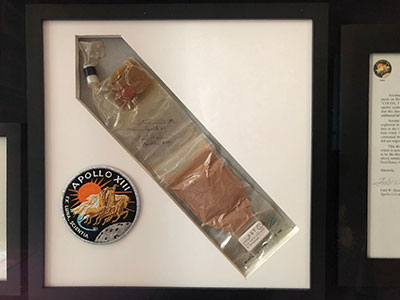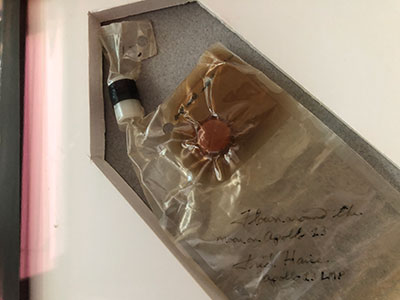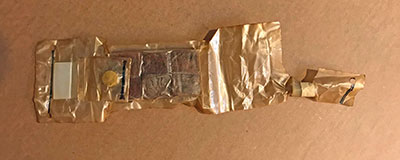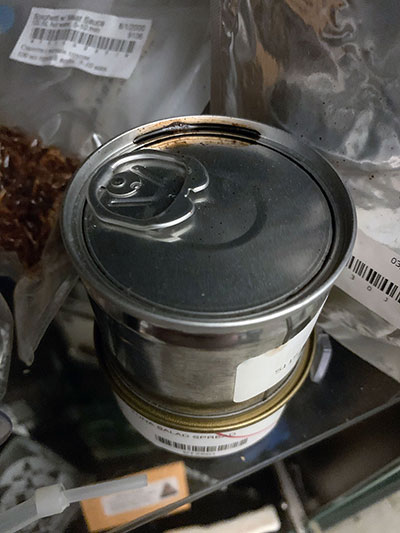|
Author
|
Topic: Space food conservation and preservation
|
mode1charlie
Member Posts: 1192
From: Honolulu, HI
Registered: Sep 2010
|
 posted 05-09-2020 06:25 PM
posted 05-09-2020 06:25 PM
   
In today's Space Hipsters Facebook Live event, I talked about some of the space food objects in my collection, one of which was an unflown Skylab can of peaches. Robert Pearlman mentioned that he knew of several such canned items — mainly decades-old Russian meat products — that have burst open. We didn't have time to get into detail about this, but I later asked Robert if he had more information, and he mentioned that the National Air and Space Museum has reported having a few canned space food items lose the integrity of their seals, and so this is something that they intend to look into once they can re-open. It also struck me that there probably should be a thread here on cS about the general topic of conserving space food objects in general (not just canned ones). So I hope this might serve as a thread that can kick start a conversation about is known about best practices in preserving space food objects in our various collections, as well as troubleshooting or solving any particular problems. |
David Carey
Member Posts: 811
From:
Registered: Mar 2009
|
 posted 05-10-2020 12:09 PM
posted 05-10-2020 12:09 PM
   
Good idea, Burke.Always considered plastic-based food packs the more fragile of the package variations and didn't know cans had their own issues. My much-loved but only food item is Fred Haise's Apollo 13 cocoa drink pack. To balance display aesthetics and conservation it sits against the acid-free gray mat in a cut pocket of thick acid-free foam board inside a shadow box frame with UV Museum Glass. This frame is actually behind a second piece of Museum Glass in a larger shadow box grouping so UV pretty well addressed. There has still been some fading to the inscription, in part from the likely poor substrate of the plastic for fine-point Sharpie ink. Also took me some months to get it behind UV glass. Writing originally was blue. Any other experiences with sharpie-type marker permanence on these plastic food packs? A flat display would probably be best to minimize potential slump/creep of the plastics and packet contents but that doesn't show as well. By supporting the entire lower edge and bottom with the 45 degree orientation there is better distribution of force and this item at least has been stable in shape since about 2010. Biocide tablet and surrounding discoloration has been also been stable. General embrittlement and degradation of plastic films remain my biggest concerns. Interested in any other food/drink pack stories and certainly open to thoughts on improvement if someone sees an error in my ways.  
|
SpaceAholic
Member Posts: 4533
From: Sierra Vista, Arizona
Registered: Nov 1999
|
 posted 05-10-2020 12:21 PM
posted 05-10-2020 12:21 PM
   
Nice job executing this display David. |
mistermac56
New Member Posts: 1
From: Gallatin, Tennessee USA
Registered: May 2020
|
 posted 05-10-2020 12:42 PM
posted 05-10-2020 12:42 PM
   
The late Rita Rapp sent me Skylab drink containers and some Apollo spoon bowl food packages for use in my nutrition science thesis and presentation back in the early 80's. I kept them in a museum grade acid free box and stored in a cool and dry place away from light. Over the years, I would occasionally check on them and around 1986, I noticed that the drink containers had started to deteriorate and drink powder leaking out. The food packages were still intact and showed no signs of deterioration. Sadly, I threw the drink containers away. The spoon bowl food packages I wound up donating to my local science museum for their collection. I can only hypothesize that the sugars in the drink mixes, over time, reacted with the plastic and ate through the containers. The drink containers were made out of polypropylene and it deteriorates faster than most plastics. One of the spoon bowl packages contained dehydrated scrambled eggs and it had turned a slight brown color, but the package was intact. One of the other spoon bowl packages contained dehydrated shrimp cocktail and it had no discoloration at all. It will be interesting to learn more from the NASM about the metal container foods deteriorating and possible reasons. I seem to remember that Carnation had provided some chicken salad spread in the metal containers under contract to NASA or their food contractor, as they had a similar commercial product on store shelves at the time. I remember buying it, as it was a quick and tasty product to pack for a lunch with crackers or bread. If this product wasn't irradiated, I imagine, over time, the enzymes in the food would off gas and cause the container to fail.
|
Rick Mulheirn
Member Posts: 4225
From: England
Registered: Feb 2001
|
 posted 05-10-2020 06:52 PM
posted 05-10-2020 06:52 PM
   
For what it is worth I have a number of unflown food packages from early fruit cake cubes circa 1965 through Apollo and Skylab to contemporary ISS packages. None of the packaging appears to have deteriorated though the fruit drink powders in two concertina beverage bottles have crystalized somewhat. Common sense precautions like avoiding sunlight, a temperate environment and avoiding handling and they should out live me at least.None have been signed so the deterioration or otherwise of signatures on such is unknown but I have seen food packages signed by Gene Cernan from his Novaspace garage sale that have remained crisp and bold. UV protective framing makes sense but over the years I have seen so many different pieces that have still faded despite such measures that I have little faith in the protective properties of archival glazing. Since modern photographic prints are coated and have been for many years the same problems associated with autographed prints with a variety of pens is to be expected. I love your Haise flown package David. A great piece. |
mode1charlie
Member Posts: 1192
From: Honolulu, HI
Registered: Sep 2010
|
 posted 05-13-2020 04:04 PM
posted 05-13-2020 04:04 PM
   
I have a question about a specific item I own: a Gemini-era item bought at auction in 2015. I think they are beef bites but not sure as there is no label.The laminate film used is different than the other food items I have (this item being thinner and more brittle) and so there a crack or some kind of breach in the material has developed such that the seal has lost integrity. (It arrived in this condition.) So there is definitely air inside the package, and indeed the whole thing has a somewhat pungent aroma. I have looked but cannot find the crack, pinhole, or whatever or wherever the source of breach is.  So my question is how best to stabilize this thing. I suppose the first thing is to identify where the breach is (see above), but then if and when I do, what is the best way to seal it (archivally, with some sort of tape with reversible adhesive, I would assume)? Thanks in advance for any advice or suggestions (including how I find the leak!). |
rgarner
Member Posts: 1233
From: Shepperton, United Kingdom
Registered: Mar 2012
|
 posted 05-13-2020 04:17 PM
posted 05-13-2020 04:17 PM
   
My suggestion would be to wrap the packet in acid free paper and seal it in a vacuum sealed bag. This way no air can get at it, or escape from it. If the seal is strong enough it should also force any residual air out of the packet, thus preserving it better. If you wanted to display it, you could do the same thing but without the acid-free paper. |
Larry McGlynn
Member Posts: 1273
From: Boston, MA
Registered: Jul 2003
|
 posted 05-13-2020 06:10 PM
posted 05-13-2020 06:10 PM
   
After reading this thread, I walked into my living room and looked at the space food in my display cases. The Skylab can of peaches is showing no signs of leaks, but I have placed it where in the event of a leak it will be controlled. I checked all the US( Mercury, Gemini, Apollo, Skylab, Shuttle), Russian (tubes, cans, packs), and Chinese food packs in the collection. With the exception of one Russian black bread package, which has expanded from off-gassing, the rest are in good shape. Yes, they have aged, hardened or discolored over time, but that is to be expected. My food packages are dropped into display cases with good airflow and little sunlight. And Burke, one book that I would highly recommend in "Combat Ready Kitchen" by Anastacia Marx de Salcedo. She does a very good job of providing the history of the military's pursuit of the perfect MRE. I have been to Natick (pronounced with a long "A" Na' Tick) Labs many times as I have friends who worked there. I have to say that I like MREs.  I am spitballing here, but I wonder if your food could be encased in lucite. It would deprive that package of O2 exposure. It might be a dumb idea, but just kicking things around. |
Robert Pearlman
Editor Posts: 43811
From: Houston, TX
Registered: Nov 1999
|
 posted 05-13-2020 08:49 PM
posted 05-13-2020 08:49 PM
   
quote:
Originally posted by mode1charlie:
...an unflown Skylab can of peaches.
This universe sure has a funny sense of humor.Inspired by my discussion with Burke, I went to check on the status of my various canned space goods after the live event on Saturday. I already had some Russian canned meats burst open and the few remaining cans I have left were moved to a separate drawer just in case. So guess what can had popped since my last check? The canned peaches. This is a surprise as the shuttle-flown can is (a) an off-the-shelf product with its commercial label removed, and (b) a lot younger than other cans I have that seem to be stable. At this point, I don't know what to do with it: open and empty it of its contents, clean it and just keep it as a flown can? Or clean off just the bit that leaked and then try to reseal it with a light application of epoxy? I am going to wait until I can hear more professional conservators but I'd love to know what history has against preserving space-flown canned peaches.  |
mode1charlie
Member Posts: 1192
From: Honolulu, HI
Registered: Sep 2010
|
 posted 05-13-2020 11:05 PM
posted 05-13-2020 11:05 PM
   
quote:
Originally posted by rgarner:
My suggestion would be to wrap the packet in acid free paper and seal it in a vacuum sealed bag.
Thanks, Richard — that's a great idea (why didn't I think of that?). On it. quote:
Originally posted by Larry McGlynn:
I wonder if your food could be encased in lucite.
That is also an excellent idea. I will look into that too. The item is about 13.5 inches long by 4 inches wide, so it would be a hefty piece of lucite — but given the almost certain degradation that has probably already started after the integrity of the seal was broken — that might be a good option. Anybody know a reliable company that can do a 15 x 6 x 1.5" lucite? |
Jim Behling
Member Posts: 1511
From: Cape Canaveral, FL
Registered: Mar 2010
|
 posted 05-14-2020 07:26 AM
posted 05-14-2020 07:26 AM
   
I have a lot of Shuttle-Mir food. I wonder about some of it, like the tubes of cottage cheese. It is starting to smell. I need to inventory it and separate good from the ones that could go bad.
|
rgarner
Member Posts: 1233
From: Shepperton, United Kingdom
Registered: Mar 2012
|
 posted 05-14-2020 11:45 AM
posted 05-14-2020 11:45 AM
   
quote:
Originally posted by Robert Pearlman:
At this point, I don't know what to do with it: open and empty it of its contents, clean it and just keep it as a flown can? Or clean off just the bit that leaked and then try to reseal it with a light application of epoxy?
Personally, I would do as little to the can as possible until you hear back from a professional. Though, at a minimum I would attempt to clean the leak using an unused, dry cloth (but be careful not to break the seal further by applying too much pressure).Lucite will most likely not stop the expansion of gas within the can (if that is indeed the culprit), I expect the gas will leak out and cause cloudiness (similar to the vintage Apollo 13 heatshield plug lucites). It could be that the contents themselves have broken down the metal container from within (being either high or low on the pH scale, meat and fruit being on the acidic side of that scale). This type of deterioration would be impossible to stop I expect. My first thought here is that you need to find the cause - only then can you take the necessary course of action to remedy the issue, which brings us back to professional advice. |
Larry McGlynn
Member Posts: 1273
From: Boston, MA
Registered: Jul 2003
|
 posted 05-14-2020 01:25 PM
posted 05-14-2020 01:25 PM
   
Robert, if all that doesn't work, then contact A&E's Eating History TV show. Maybe Old Smokey and Josh can sample it for you. I can guarantee that you and I will not be tasting it. Well, at least, not me.  |
p51
Member Posts: 1668
From: Olympia, WA
Registered: Sep 2011
|
 posted 05-14-2020 06:19 PM
posted 05-14-2020 06:19 PM
   
I know that this is a problem for people collecting World War Two items, because K rations from that time had one can, and most of them pop over time.Perhaps, contacting one of the preservation people at the US Army Historical Branch at Carlisle, Pennsylvania might get some sort of insight as to how they would, or might, preserve something like that? |
pupnik
Member Posts: 116
From: Maryland
Registered: Jan 2014
|
 posted 05-15-2020 04:58 PM
posted 05-15-2020 04:58 PM
  
On potential option for plastic sealed food is to overpack it. Place it in a larger sealed container. Vacuum seal it or fill the void with nitrogen.Things with already lost, or failing, integrity may have a problem with vacuum sealing if the process could draw any of the contents to the outside of the package. |
















